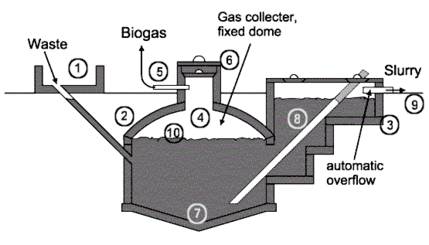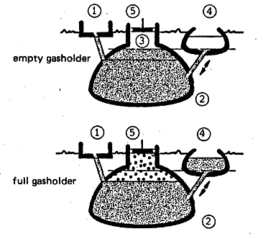Fixed-dome Biogas Plants
Overview
There are different types of small scale biogas digesters. Some of the biogas digesters are summarized below:
The table below gives a first comparison of the different types.
Factors |
Fixed dome |
Floating drum |
Tubular design |
Plastic containers |
|---|---|---|---|---|
Gas storage |
Internal Gas storage up to 20 m³ (large) |
Internal Gas storage drum size (small) |
Internal eventually external plastic bags |
Internal Gas storage drum sizes (small) |
Gas pressure |
Between 60 and 120 mbar |
Upto 20 mbar |
Low, around 2 mbar |
Low around 2mbar |
Skills of contractor |
High; masonry, plumbing |
High; masonry, plumbing, welding |
Medium; plumbing |
Low; plumbing |
Availability of Material |
yes |
yes |
yes |
yes |
Durability |
Very high >20 years |
High; drum is weakness |
Medium; Depending on chosen liner |
Medium
|
Agitation |
Self agitated by Biogas pressure |
Manual steering |
Not possible; plug flow type |
Evtl Manual steering |
Sizing |
6 to 124 m³ digester vol |
Up to 20 m³ |
Combination possible |
Up to 6 m³ digester vol |
Methane emission |
High |
Medium |
Low |
Medium |
Fixed-dome Plants
A fixed-dome plant consists of a digester with a fixed, non-movable gas holder, which sits on top of the digester. When gas production starts, the slurry is displaced into the compensation tank. Gas pressure increases with the volume of gas stored and the height difference between the slurry level in the digester and the slurry level in the compensation tank. The costs of a fixed-dome biogas plant are relatively low. It is simple as no moving parts exist. There are also no rusting steel parts and hence a long life of the plant (20 years or more) can be expected. The plant is constructed underground, protecting it from physical damage and saving space. While the underground digester is protected from low temperatures at night and during cold seasons, sunshine and warm seasons take longer to heat up the digester. No day/night fluctuations of temperature in the digester positively influence the bacteriological processes. The construction of fixed dome plants is labor-intensive, thus creating local employment. Fixed-dome plants are not easy to build. They should only be built where construction can be supervised by experienced biogas technicians. Otherwise plants may not be gas-tight (porosity and cracks).
The basic elements of a fixed dome plant (here the Nicarao Design) are shown in the figure below.
Function
A fixed-dome plant comprises of a closed, dome-shaped digester with an immovable, rigid gas-holder and a displacement pit, also named 'compensation tank'. The gas is stored in the upper part of the digester. When gas production commences, the slurry is displaced into the compensating tank. Gas pressure increases with the volume of gas stored, i.e. with the height difference between the two slurry levels. If there is little gas in the gas-holder, the gas pressure is low.
Digester
The digesters of fixed-dome plants are usually masonry structures, structures of cement and ferro-cement exist. Main parameters for the choice of material are:
- Technical suitability (stability, gas- and liquid tightness);
- cost-effectiveness;
- availability in the region and transport costs;
- availability of local skills for working with the particular building material.
Fixed dome plants produce just as much gas as floating-drum plants, if they are gas-tight. However, utilization of the gas is less effective as the gas pressure fluctuates substantially. Burners and other simple appliances cannot be set in an optimal way. If the gas is required at constant pressure (e.g., for engines), a gas pressure regulator or a floating gas-holder is necessary.
Gas-Holder
The top part of a fixed-dome plant (the gas space) must be gas-tight. Concrete, masonry and cement rendering are not gas-tight. The gas space must therefore be painted with a gas-tight layer (e.g. 'Water-proofer', Latex or synthetic paints). A possibility to reduce the risk of cracking of the gas-holder consists in the construction of a weak-ring in the masonry of the digester. This "ring" is a flexible joint between the lower (water-proof) and the upper (gas-proof) part of the hemispherical structure. It prevents cracks that develop due to the hydrostatic pressure in the lower parts to move into the upper parts of the gas-holder.
Types of Fixed-dome Plants
- Chinese fixed-dome plant is the archetype of all fixed dome plants. Several million have been constructed in China. The digester consists of a cylinder with round bottom and top.
- Janata model was the first fixed-dome design in India, as a response to the Chinese fixed dome plant. It is not constructed anymore. The mode of construction lead to cracks in the gasholder - very few of these plant had been gas-tight.
- Deenbandhu, the successor of the Janata plant in India, with improved design, was more crack-proof and consumed less building material than the Janata plant. with a hemisphere digester
- CAMARTEC model has a simplified structure of a hemispherical dome shell based on a rigid foundation ring only and a calculated joint of fraction, the so-called weak / strong ring. It was developed in the late 80s in Tanzania.
- AKUT fixed dome plant is an improvement of the above mentioned Nicaragua design. Digester volumes ranges from 8 to 124 m³ with gas storages from 2 to 19,4 m³; the gas production can reach 60 m³/d. The units from 32 m³ onwards are often used for small scale productive use including electricity generation. It has a cylindrical base with a spheric top. The expansion chamber acts as overpressure outlet.
- AKUT Maendaleo (kisuaheli "progress") adds a gas storage ballon to collect access gas from the digestion chamber. This can be used for converted Diesel generators.
Climate and Size
Fixed-dome plants must be covered with earth up to the top of the gas-filled space to counteract the internal pressure (up to 0,15 bar). The earth cover insulation and the option for internal heating makes them suitable for colder climates. Due to economic parameters, the recommended minimum size of a fixed-dome plant is 5 m3. Digester volumes up to 200 m3 are known and possible.
Summary
Advantages: Low initial costs and long useful life-span; no moving or rusting parts involved; basic design is compact, saves space and is well insulated; construction creates local employment. Advantages are the relatively low construction costs, the absence of moving parts and rusting steel parts. If well constructed, fixed dome plants have a long life span. The underground construction saves space and protects the digester from temperature changes. The construction provides opportunities for skilled local employment.
Disadvantages: Masonry gas-holders require special sealants and high technical skills for gas-tight construction; gas leaks occur quite frequently; fluctuating gas pressure complicates gas utilization; amount of gas produced is not immediately visible, plant operation not readily understandable; fixed dome plants need exact planning of levels; excavation can be difficult and expensive in bedrock. Disadvantages are mainly the frequent problems with the gas-tightness of the brickwork gas holder (a small crack in the upper brickwork can cause heavy losses of biogas). Fixed-dome plants are, therefore, recommended only where construction can be supervised by experienced biogas technicians. The gas pressure fluctuates substantially depending on the volume of the stored gas. Even though the underground construction buffers temperature extremes, digester temperatures are generally low. Fixed dome plants can be recommended only where construction can be supervised by experienced biogas technicians.
A specific environmental disadvantage is methane emission from the expansion chamber.
Variations: Some companies are now looking into small pre-fab fixed dome plants made of fibreglass which appears to be a low cost alternative to construction intensive masoned plants. A custom made plant can be produced in 2 days and -after transport- installed in less than 1 day!
Criteria for the selection of a type and design
A biogas plant should serve the owner of the plant. There it must be in any case financially viable, the benefits have to exceed the investment. In addition it has to be user friendly. easy to be fed and to be operated.
A sufficient gas storage is mandatory; a capacity of 10 hours is for many cases acceptable. In a domestic set up Biogas will not be used for 10 hours during the night. A small gas storage will lead to methane emissions and to monetary losses.
A gas presure of 10 mbar at least seem to be necessary to operate a burner. On ballon storages this load of 10 kg/m² surface have to applied to get enough pressure.
Further Information
References
This article is a continuation of the article, Types of Biogas Digesters and Plants. For questions regarding the article, please contact the authors of this article as well as those of the article, Types of Biogas Digesters and Plants.























